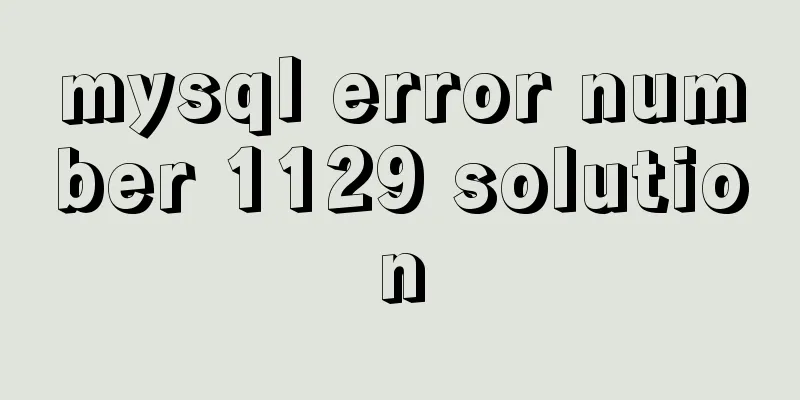Analyze several common solutions to MySQL exceptions

PrefaceThe error is as follows:
For this type of error, just look at the explanation. In one sentence: The JDBC driver threw an exception and could not connect to the database. 1. The database name or password configured by the code is inconsistent with the local database1.1. Error descriptionThe first and most common error is that the database name or password configured by the code is inconsistent with the local database, and an exception is thrown.
As shown in the figure above, in the configuration file, the name attribute in front is the default and does not need to be changed. For the user name, it is generally root. You can directly view the local configuration through the database management software. The database password is set by you. 1.2 SolutionModify the name and password of the configuration file.
2. The imported non-local project file does not match the local database version2.1. Error descriptionThe second common error: The non-local project file imported using IDE (Eclipse for example) does not match the local database version. For example: the jar package you import into your eclipse project depends on version 8.0, but the MySQL database you installed locally is version 5.0, so an error will naturally occur. 2.2 SolutionFind Referenced Libraries in the project you imported, right-click → Build Path → Configure Build Path…Remove the 8.0 MySQL driver that the project depends on, and add the 5.0 version you installed locally.
3. Error in loading driver package in higher version of MySQL configuration (taking MySQL 8.0 as an example)This error is caused by the change of the driver package after the MySQL version is updated. The new driver class is com.mysql.cj.jdbc.Driver. 3.1. Error descriptionThe error is as follows:
Error Description: The driver class 'com.mysql.jdbc.Driver' is deprecated. The new driver class is 'com.mysql.cj.jdbc.Driver'. The driver is automatically registered via SPI, so there is usually no need to manually load the driver class. 3.2 SolutionChange the driver class com.mysql.jdbc.Driver used by MySQL database 5.0 to com.mysql.cj.jdbc.Driver. The driver is automatically registered through SPI, and usually there is no need to manually load the driver class. The modified configuration file is shown in the figure below:
<!-- Load database driver--> <property name="driverClass" value="com.mysql.cj.jdbc.Driver"></property> 3.3. How to view driver classes of different versions of MySQLFor the MySQL driver class, when we check each version, we can directly check where the driver is located by clicking on the driver jar package. For example, the 8.0 version is com.mysql.cj.jdbc.Driver, as shown in the following figure:
4. Database connection string high version configuration error (time zone problem)Note: You need to configure the time zone after MySQL version 6.0. 4.1. Error descriptionThe error is as follows:
4.2 SolutionWe can take advantage of time zone support by configuring the server or JDBC driver (via the serverTimezone configuration property) to use a more specific time zone value. The configuration files are as follows: <!-- Database connection string --> <property name="jdbcUrl" value="jdbc:mysql://localhost:3306/demo?serverTimezone=GMT%2B8&characterEncoding=utf-8"></property> 5. Why is there an 8-hour difference in writing data into the database?5.1. Error descriptionJava database connection uses the UTC time zone (Coordinated Universal Time), that is, serverTimezone=UTC, and Beijing time is 8 hours earlier than UTC time, that is, UTC+08:00. If we directly use serverTimezone=UTC, the data written to the database will be 8 hours ahead. If the following configuration is used, the data written into the database will be 8 hours apart: <!-- Database connection string --> <property name="jdbcUrl" value="jdbc:mysql://localhost:3306/demo?serverTimezone=UTC&characterEncoding=utf-8"></property> 5.2 SolutionWe can modify the serverTimezone to Beijing time GMT%, Shanghai time Asia/Shanghai or Hongkong time Hongkong. The configuration file is as follows: <!-- Database connection string --> <property name="jdbcUrl" value="jdbc:mysql://localhost:3306/demo?serverTimezone=GMT%2B8&characterEncoding=utf-8"></property> In addition, the my.ini configuration file in MySQL can also be modified. This article is only used to solve the corresponding problem, so it will not be described in detail. 6. SSL connection issues6.1. Error descriptionThe error is as follows:
Error Description: Establishing an SSL connection without server authentication is not recommended. According to the SSL connection requirements of MySQL 5.5.45+, 5.6.26+, and 5.7.6+, if the connection mode is not set, an SSL connection must be established by default. For existing applications that do not use SSL, the server's verify-certificate property is set to "false". You need to either explicitly disable SSL by setting useSSL=false, or set useSSL=true and provide a verified certificate for the server. 6.2 Solution
The configuration file is as follows: <!-- Database connection string --> <property name="jdbcUrl" value="jdbc:mysql://localhost:3306/demo?useSSL=false&serverTimezone=GMT%2B8&characterEncoding=utf-8"></property> SummarizeBy summarizing several common solutions to MySQL exceptions, you can deepen your understanding of the underlying MySQL. As long as you are doing development, mistakes will happen constantly, so you must be good at summarizing. At the same time, you must fully grasp the underlying principles of development, and as a developer you must keep abreast of different version iterations, otherwise you will never keep up with technological development. The above is a detailed analysis of several common solutions to MySQL exceptions. For more information on solutions to MySQL exceptions, please pay attention to other related articles on 123WORDPRESS.COM! You may also be interested in:
|
<<: Design Story: The Security Guard Who Can't Remember License Plates
>>: How to use @media in mobile adaptive styles
Recommend
Pure CSS to achieve candle melting (water droplets) sample code
Achieve results Implementation ideas The melting ...
How to query json in the database in mysql5.6 and below
When saving data in MySQL, sometimes some messy a...
A simple way to clear the CSS, JavaScript and background image cache in the browser
In the actual project development process, the pag...
Perfect solution to the problem of data being truncated when using the group concat function in Mysql5.7
The day before yesterday, I encountered a problem...
Docker network mode and configuration method
1. Docker Network Mode When docker run creates a ...
Detailed explanation of views in MySQL
view: Views in MySQL have many similarities with ...
UTF-8 and GB2312 web encoding
Recently, many students have asked me about web p...
Modify file permissions (ownership) under Linux
Linux and Unix are multi-user operating systems, ...
CSS3 realizes various graphic effects of small arrows
It’s great to use CSS to realize various graphics...
Today I will share some rare but useful JS techniques
1. Back button Use history.back() to create a bro...
Implementation of Docker to build private warehouse (registry and Harbor)
As more and more Docker images are used, there ne...
Navicat connects to MySQL8.0.11 and an error 2059 occurs
mistake The following error occurs when connectin...
How to switch directories efficiently in Linux
When it comes to switching directories under Linu...
Vue imitates ElementUI's form example code
Implementation requirements The form imitating El...
Vue implements custom "modal pop-up window" component example code
Table of contents Preface Rendering Example Code ...
















